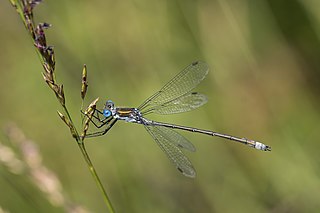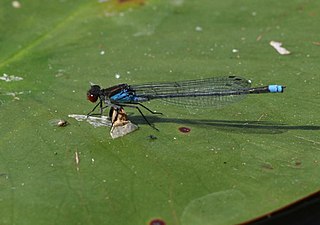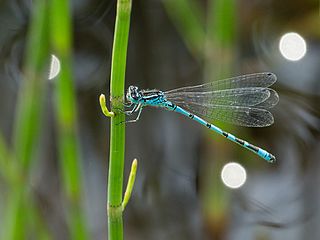
A dragonfly is a flying insect belonging to the infraorder Anisoptera below the order Odonata. About 3,000 extant species of dragonflies are known. Most are tropical, with fewer species in temperate regions. Loss of wetland habitat threatens dragonfly populations around the world. Adult dragonflies are characterised by a pair of large, multifaceted, compound eyes, two pairs of strong, transparent wings, sometimes with coloured patches, and an elongated body. Many dragonflies have brilliant iridescent or metallic colours produced by structural coloration, making them conspicuous in flight. An adult dragonfly's compound eyes have nearly 24,000 ommatidia each.

Damselflies are flying insects of the suborder Zygoptera in the order Odonata. They are similar to dragonflies but are usually smaller and have slimmer bodies. Most species fold the wings along the body when at rest, unlike dragonflies which hold the wings flat and away from the body. Damselflies have existed since the Jurassic, and are found on every continent except Antarctica.

The banded demoiselle is a species of damselfly belonging to the family Calopterygidae. It is often found along slow-flowing streams and rivers. It is a Eurasian species occurring from the Atlantic coast eastwards to Lake Baikal and northwestern China.

The blue-tailed damselfly or common bluetail is a damselfly, belonging to the family Coenagrionidae.

The small red-eyed damselfly is a member of the damselfly family Coenagrionidae. It is very similar to the red-eyed damselfly.

Coenagrionidae or are a family of damselflies, also known as pond damselfies, in the order Odonata and the suborder Zygoptera. The Zygoptera are the damselflies, which although less known than the dragonflies, are no less common. More than 1,300 species are in this family, making it the largest damselfly family. The family Coenagrionidae has six subfamilies: Agriocnemidinae, Argiinae, Coenagrioninae, Ischnurinae, Leptobasinae, and Pseudagrioninae.

The small red damselfly is a small damselfly flying in heathland bogs and streams. It is in the family Coenagrionidae.

Sandhurst to Owlsmoor Bogs and Heaths is an 85.8-hectare (212-acre) biological Site of Special Scientific Interest (SSSI) on the northern outskirts of Sandhurst in Berkshire. Part of the SSSI is Wildmoor Heath nature reserve, which is managed by the Berkshire, Buckinghamshire and Oxfordshire Wildlife Trust. and the SSSI is part of Thames Basin Heaths Special Protection Area.

The goblet-marked damselfly is a medium-sized blue-and-black damselfly in the pond damselfly family (Coenagrionidae). It's a fairly common species in the South and West of Europe but is not found in the British Isles, Scandinavia and Eastern Europe. Erythromma lindenii was previously known as Coenagrion lindenii and Cercion lindenii. The goblet-marked damselfly is also known as the blue-eye. It's an easily recognized species, with its wide antehumeral stripes, narrow postocular spots, the male's very bright-blue eyes. He has very long and curved appendages, and the spear-shaped marks on S3-S6 of his abdomen.

Sympecma fusca, the common winter damselfly, is a damselfly a member of the Lestidae and related to the emeralds or spreadwings.

Lestes sponsa is a damselfly with a wide Palaearctic distribution. It is known commonly as the emerald damselfly or common spreadwing. Both males and females have a metallic green colour and brown wing spots. It resides near pools with aquatic plants. When resting its wings are usually half opened.

Lestes dryas is a species of damselfly in the family Lestidae, the spreadwings. Its common names include emerald spreadwing, scarce emerald damselfly and robust spreadwing. An alternate name in Ireland is the turlough spreadwing.

Chalcolestes viridis, formerly Lestes viridis, is a damselfly of the family Lestidae. It has a metallic green body and at rest it holds its wings away from its body. Its common name is the willow emerald damselfly, the green emerald damselfly, or the western willow spreadwing. It has an elongated abdomen and pale brown spots on its wings and resides in areas of still water with overhanging trees.

Erythromma is a genus of damselfly in the family Coenagrionidae. It contains the following species:

Coenagrion ornatum, or, the ornate bluet, is a species of damselfly from the family Coenagrionidae distributed across a large part of Europe and Western Asia.


















